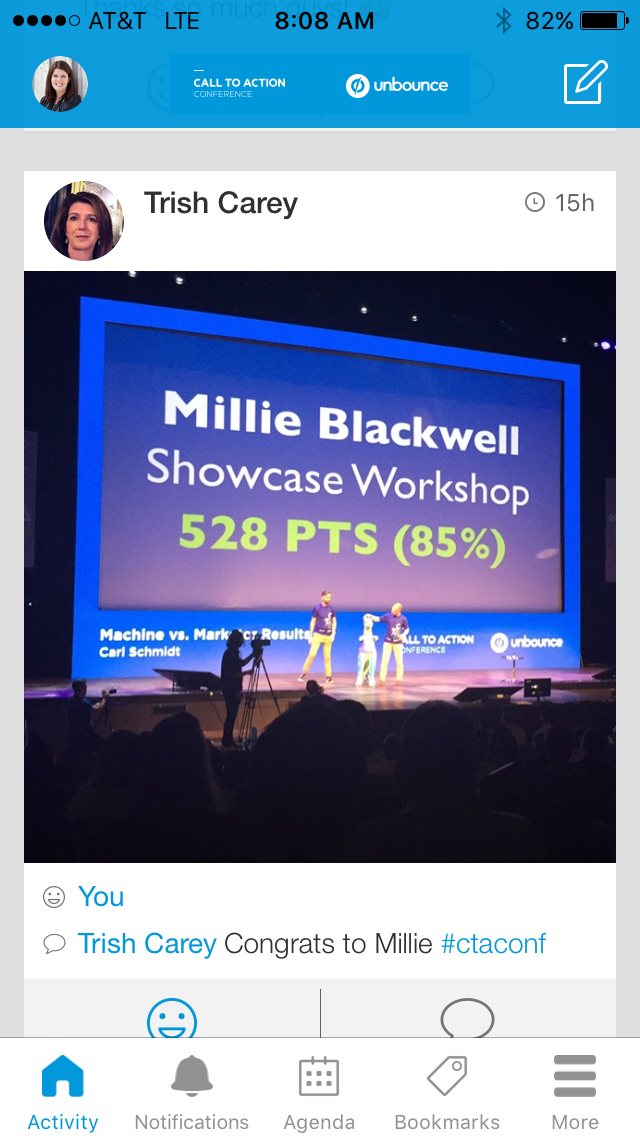Note from Millie:
This is post #2 in the CTA Series, a recap of my biggest takeaways from the 2017 Unbounce CTA Conference. If you missed the first post, there’s a link at the bottom of this post.
I want to share a story with you before we dive in, here.
Unbounce is heavily investing in artificial intelligence (AI), and they’re putting machines to the test. They created a game called “Machine vs. Marketer” and launched it in their conference app for us attendees to try out.
The challenge was to go through 204 real landing pages and predict if each page had been a low- or high-converting page. While we participants were making our judgment calls, AI technology was analysing the copy and making its own prediction.
The winning human score? Yes, it was yours truly.

While I got the highest human score, ultimately the machine won. By quite a convincing margin.*
Why? Because the machine was only looking at the copy — the words — on the pages. We, humans, were influenced by the design and layout.
The words we use in our marketing are the most powerful tools we have to influence buyers. We must pay more attention to them.
And that leads us to …
Want Your Customers to Hear You? Speak a Different Language
Conversion Copywriter Joel Klettke's talk at The Unbounce CTA Conference left nothing to be desired — which is telling, since it was only about 20 minutes long. He crammed a metric ton of part-the-clouds, angels singing, shining golden nuggets of insight into his quick talk.
Though the entire presentation was fascinating, the key takeaway for me, was his tactics for mining the information you already have to learn your customer’s language and then use it in your marketing campaigns.
Get Out of Your Own Way
A successful marketing campaign triggers a two-way sales conversation. Talking only about ourselves creates a one-way conversation. Yet we sometimes still feel compelled to talk only about ourselves in our marketing assets. At length. Ad nauseum.
Self-focused marketing (and self-focused sales conversations) are easy to identify. They use vague language or completely meaningless jargon and speaks only about the company and the product.
Successful marketing addresses the customer’s pain points, desired goals and priorities.
Take the focus off yourself (or your solution, for that matter) and gear the marketing conversation toward the most important thing to the customer: themselves.
How do you do this?
- Listen.
- Learn the language.
- Speak the language.
Listen First
You’ve got a whole library of resources for customer insight at your fingertips. Testimonials, reviews, customer interviews, surveys, and chat logs are full of juicy information that can help you create better marketing campaigns.
Testimonials and reviews alone, though, can give you a running start to learning your customer’s language. So let’s begin there.
Pull out those positive customer reviews and testimonials. Put them in a spreadsheet so you can sort them, rank them and make notes on them.
Now go grab reviews and testimonials of your competitor’s products. Put those in another tab on that same spreadsheet.
Spend some time reading through them all and immersing yourself in your customer’s own words - whether they're your customer or your competitors' customer the language is likely the same.
Learn the Language
To really learn your customer’s language, you need to do a bit of analysis.
Still looking at that spreadsheet, see if you can identify any recurring themes.
Also be on the lookout for frequently used words. You can use free word-cloud software like wordclouds.com to pull those out and get a clearer view of them.
These themes and words are top-of-mind for your customers. They illustrate pain points, goals and problems — but most importantly, they are words your customer can connect with because they said them.
Speak the Language
Now that you have learned your customer’s language — speak it in your marketing.
Talk first about things your customers talk about most. This changes the entire flow of the marketing conversation. Now you’re starting off talking about the customer rather than yourself — and they’ll sit up and pay attention because you’re speaking their own language.
Use the exact words your customers used in those reviews and testimonials. Ditch the jargon. Speak the language of your customer and they’re more likely to actually hear what you’re saying.
This actually sets your sales team up for better sales conversations, too. Leading with customer-focused marketing and sales-enablement content triggers that invaluable two-way sales conversation flow.
It’s No Longer Greek to Your Customers
Look at your customer reviews and testimonials and pick up on any themes or frequently used words. This is the language of your customers, and when you speak it back to them, they’ll hear and understand you better.
You have everything you need in your customer’s own words to change the marketing conversation from “me, me, me” to “let’s solve your problem together.”
Read Part 1, How Popeye Single-handedly Saved the Spinach Industry.
*Truthfully, I got the highest score by exploiting a bug I found in the game. If you look closely at the photo you'll see the hosts holding a giant toy dinosaur. More on that in the last post...